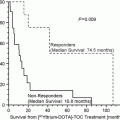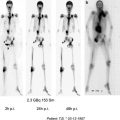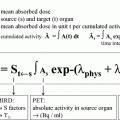© Springer-Verlag Berlin Heidelberg 2012
Richard P. Baum (ed.)Therapeutic Nuclear MedicineMedical Radiology10.1007/174_2012_734Treatment of Lymphoma with 131I-Chimeric Monoclonal Antibodies
(1)
School of Medicine and Pharmacology, Department of Nuclear Medicine, The University of Western Australia, Fremantle hospital, Alma street, Fremantle, WA 6160, Australia
Abstract
Radioimmunotherapy is a safe, effective treatment of low grade lymphoma and increases overall survival, whilst preserving quality of life. Efficacy is comparable with that of standard rituximab chemotherapy regimens and 131I-rituximab radioimmunotherapy is associated with less toxicity. Radioiodinated chimeric anti-CD 20 monoclonal antibody offers practical, cost-effective radioimmunotherapy for routine clinical applications where regulatory or cost constraints limit the availability of proprietary radiolabelled murine anti-CD 20 monoclonal antibodies. 131I-rituximab has, in addition, the potential for safe, effective, repeated radioimmunotherapy upon relapse of non-Hodgkin lymphoma.
1 Key Points
Chimeric anti-CD 20 Mab may be easily and safely radiolabelled with Iodine-131 in a university hospital nuclear medicine laboratory for radioimmunotherapy (RIT) of non-Hodgkin lymphoma (NHL). 131I-rituximab provides safe, effective, practical, affordable and available RIT for patients with indolent NHL upon first presentation, or with relapsed or refractory disease or requiring consolidation of chemotherapy. More aggressive NHL such as mantle cell lymphoma, DLBCL or aggressive transformation may respond to non-myleoablative 131I-rituximab or RIT conditioning for marrow transplantation.
Patients with NHL who respond to 131I-rituximab RIT may be retreated upon relapse with expectation of renewed response without additional toxicity. Toxicity of the non-myeloablative 131I-rituximab RIT regimen is modest being self-limited myelosuppression and occasional hypothyroidism.
2 Introduction
Indolent non-Hodgkin lymphoma (NHL), prior to the advent of the chimeric anti-CD 20 monoclonal antibody (Mab) rituximab, had a relentless progressive relapsing course (Horning 1993). Median survival for advanced indolent NHL was less than ten years and median survival after relapse was less than five years (Johnson et al. 1995). Rituximab was first approved for immunotherapy of NHL in 1997 by the FDA and soon afterwards in Europe, Australia and elsewhere. The chimerization of the murine anti-CD 20 Mab circumvented problems of immunogenicity and potential formation of human anti-mouse antibody (HAMA) and allows repeated and maintenance rituximab treatments which have revolutionized the management of NHL. (Marcus et al. 2008; van Oers 2007).
Monotherapy with rituximab achieves only modest, relatively short-lived responses ORR 50 % complete remission (CR) 5 %, median duration response eleven months (McLauglin et al. 1998). However, rituximab in combination with conventional chemotherapy regimens such as R-CHOP and R-CVP is the current standard of care for indolent NHL (Marcus et al. 2008).
Radioimmunotherapy of NHL with 131I-rituximab combines standard dose chimeric anti-CD 20 Mab immunotherapy with tumour targeting internal radiation. The beta emission of iodine-131 has a range in tissue of 200 cell diameters and irradiates not only the target cell but also, by a cross-fire effect, irradiates adjacent tumour cells which may not express the CD-20 antigen or are inaccessible to the antibody. In addition, rituximab enhances the inherent exquisite radiation sensitivity of NHL and synergistically activates apoptotic signalling of tumour cells (Skvortsova et al. 2006; Kapadia et al. 2008).
Radioiodination of IgG1 antibodies, such as rituximab, is routine, easy and fast, using established methods with Chloramine T (Hunter and Greenwood 1962; Turner et al. 2003) or iodogen (Illidge et al. 2009; Tran et al. 2009).
Clinical RIT of NHL with 131I-rituximab was commenced in 1999 in an attempt to emulate the efficacy of R-CHOP and other chemotherapeutic regimens, whilst avoiding their toxicity. The use of radiolabelled chimeric anti-CD 20 Mab is very important, since NHL remains an essentially incurable cancer and repeat 131I-rituximab RIT can be offered when the lymphoma inevitably recurs. Furthermore, such RIT does not compromise subsequent therapy options for treatment of aggressive transformation of NHL.
This chapter describes the clinical application of 131I-rituximab RIT in the management of relapsed or refractory indolent NHL and also explores repeat RIT for relapsed NHL, first-line RIT and combination of 131I-rituximab RIT with chemotherapy for consolidation in refractory NHL, and conditioning RIT prior to marrow ablation and autologous stem cell transplant.
Radiolabeled chimeric anti-CD 20 Mab such as 131I-rituximab are not approved for clinical use in the US or European Union but 131 I-rituximab is available for research and for compassionate patient usage in other regulatory jurisdictions such as Australia. We here review our ten year clinical experience of safe, cost-effective, practical RIT of NHL supplemented by published research studies of 131I-rituximab RIT.
3 Chimeric Antibody and Radiolabeling
3.1 Chimeric Antibody
Rituximab is a genetically engineered chimeric anti-CD 20 Mab that has murine light-and heavy-chain variable regions and human γ1 and κ light-chain constant regions (IgG1 κ isotype) (Anderson et al. 1997). The chimeric Mab is composed of two heavy chains of 451 amino acids and two light chains of 213 amino acids and has an approximate molecular weight of 145 kDa (Grillo-López 2003). Rituximab was engineered with human constant regions to decrease immunogenicity and to enable it to bind complement and effector cells (Reff et al. 1994). It is more effective than in its murine parent in fixing complement and mediating antibody-dependent cellular cytotoxicity and it effects complement-dependent cytotoxicity in the presence of human complement (Anderson et al. 1997).
3.2 Radiolabelling by Chloramine T method
Iodine-131 radioiodination of rituximab is performed in a hospital nuclear medicine radiopharmaceutical laboratory in a simple thirty minute semi-automated procedure (Turner et al. 2003). Briefly, protein-labelling grade 131I-sodium iodide, which contains no stabilizing agent, is used within 24 h of manufacture, being shipped in a 10 ml sterile vial which constitutes the reaction vessel. Rituximab, 15 mg from a sterile, undiluted patient dose, is added to 6 GBq radioiodine with Chloramine T and incubated at room temperature for 5 min and the reaction is then quenched with sodium thiosulphate. Purification is performed on a shielded proprietary sterile semi-automated commercially available kit (Therap-I Mab kit™ Go Medical Industries Pty Ltd Australia) and quality control performed on ITLC silica gel. Manufacture is performed on protocols approved by the National Association of Testing Authorities (NATA). Radiochemical purity is routinely above 99 % with retention of immunoreactivity >80 % (Turner et al. 2003). It is however important to administer therapeutic activities to patients within one hour of radiolabeling, to avoid radiolysis of the antibody, since no radioprotective agents are used.
3.3 Radiolabelling by Iodogen Method
Solid state methods, such as iodogen, for radioiodination of proteins (Markwell 1982) have been subsequently modified (Visser et al. 2001) and recently refined (Tran et al. 2009) to achieve labelling efficacy of 131I-rituximab of 95–98 % and immunoreactivity of around 70 % (Illidge et al. 2009; Tran et al. 2009). The iodogen and Chloramine T radiolabelling methods for 131I-rituximab are both simple, rapid and efficient and radiation exposure to laboratory personnel is minimal.
4 Pharmacokinetics and Dosimetry
4.1 Pharmacokinetics
The mean circulating half-life in patients with non-Hodgkin lymphoma is similar for 131I-rituximab labelled by Chloramine T 85.4 h (46–115) (Turner et al. 2003) or Iodogen 87.9 h (40–134) (Scheidhauer et al. 2002) and is longer than that of its murine anti-CD 20 Mab counterpart 131I-tositumomab at 56 h (Kaminski et al. 2000).
Whole body activity decreases monoexponentially with a wide range of effective half-lives which mandate individual prospective dosimetry for safe, effective 131I-rituximab RIT. The mean effective 131I-rituximab half-life of 85–90 h is seen in NHL lymphoma undergoing standard RIT with predose unlabelled rituximab at 375 mg/m2 which improves tumour targeting and obviates splenic sequestration of activity (Illidge et al. 2009). Studies of patients receiving 131I-rituximab in the absence of prior unlabelled Mab show mean effective half-life of 45 h (40–55) compared with 93 h (66–113) in the same patients after rituximab predosing (Illidge et al. 2009). Fractionation of 131I-rituximab therapy may also significantly increase the effective half-life of the subsequent dose (Illidge et al. 2009).
4.2 Dosimetry
Prescription of the whole body radiation absorbed dose of 0.75 Gy (equivalent to <2.0 Gy to red marrow) by prospective individual dosimetry gamma imaging of a tracer 200 MBq 131 I-rituximab determines the safe, therapeutic activity for each patient and minimizes myelotoxicity. Following predosing with 375 mg/m2 unlabelled rituximab the tracer 200 MBq 131I-rituximab is administered intravenously and whole body gamma imaging performed at 1 h, 4 days and 7 days under identical geometry on the same gamma camera. The automated generation of a dose-activity relation curve based upon individual patient whole body retention of the tracer activity of 131I-rituximab calculates the therapy activity (GBq) which will limit whole body radiation absorbed dose to 0.75 Gy (Turner 2009). Validation of this dosimetric methodology by quantitative SPECT/CT imaging of lumbo sacral spine and blood sampling after tracer and therapy activities of 131I-rituximab demonstrates a median radiation absorbed dose of 1.56 Gy (1.09–1.9) to red marrow when the administered activity was prescribed according to a calculated whole body radiation absorbed dose of 0.75 Gy (Boucek and Turner 2005).
5 Radiation Protection
Shielded remote handling semi-automated radiolabeling facilities and NATA accredited manufacturing protocols ensure the radiation safety of laboratory personnel. The dispensing and calibration of all 131I-rituximab therapy doses is witnessed by the administering nuclear physician to avoid misadministration. Shielded IV infusion units and disposable administration kits (TRIP kit Go Medical Pty Ltd Australia) minimise radiation exposure of medical, nursing and physics personnel.
Inpatient RIT is performed in a dedicated isolation unit with trained nursing staff equipped with personal dosimeters and the patient is confined for 4–6 days until release levels of 131I radioactivity are attained. In Australia, the retained activity at discharge is <600 MBq 131I.
Stay updated, free articles. Join our Telegram channel

Full access? Get Clinical Tree







